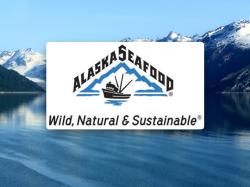Wild Alaska Salmon Season Kicks Off May 16
May 10, 2016 | 4 min to read

JUNEAU, Alaska — The highly-anticipated harvest for the five species of wild Alaska salmon kicks off on May 16 with the first of the season sockeyes and kings making their way into retailers and restaurants nationwide. The harvest season for pink, keta, and coho salmon will follow in late May and continue through October meaning flavorful wild Alaska salmon will be available all summer long. One of the most popular fish in the country, more than 90 percent of the wild salmon harvested in the United States comes from the pristine, icy waters of Alaska resulting in unparalleled flavor, exceptional quality, and fishermen following some of the best sustainable fishing practices in the world.
From the rich, robust flavor of sockeye to the delicate flavor of coho, the five unique species of wild Alaska salmon offer an array of flavorful options for every taste, budget and cooking technique that can be enjoyed fresh during summer, and frozen and canned year-round. Plus, with the 2015 Dietary Guidelines recommending at least 8 ounces of seafood per week, consumers can rely on wild Alaska salmon as a healthful, excellent source of protein and omega-3 fatty acids.
With 161 million salmon forecast, this season marks the perfect time to give all five species a try including:
-
Sockeye – Also known as red salmon, Alaska sockeye is one of the most popular salmon species due to its deep red color and rich salmon flavor. The firm texture of sockeye makes it perfect for almost all preparation techniques, including grilling, broiling, sautéing, roasting, poaching, steaming and smoking. Alaska sockeye salmon is available fresh from mid-May through mid-September and frozen year-round.
Recipe suggestion: Alaska Salmon Burgers with Rhubarb Chutney -
King – Championed for its size and succulent flavor, king salmon, also known as chinook, is the largest of the five Alaska salmon species and also bears the highest fat content. Similar to sockeye, king salmon features a rich red flesh and lends itself well to most cooking techniques. Although mostly caught in the summer, some Alaska king salmon is harvested year round for fresh and frozen availability.
Recipe suggestion: Cedar Plank Grilled Alaska Salmon with Sweet Potatoes -
Pink – True to its name, Alaska pink salmon has rosy pink-colored flesh. The most abundant and affordable of the five Alaska salmon species, pink salmon is known for its delicate flavor and tender texture. This species is often available canned but is also great for smoking. Decreased cooking temperatures are recommended when preparing pink salmon because of its lower oil content. Wild Alaska pink salmon is available June through September and frozen year-round.
Recipe suggestion: Southwest Salmon Quinoa Cakes over Mixed Greens -
Keta – Keta, also known as silverbrite or chum, features a mild flavor and tempting pink color. This extremely versatile species is good for smoking, and due to its firm texture, it is a great choice for grilling or roasting. Like pink salmon, it is best to prepare keta at decreased cooking temperatures due to its lower oil content. Wild Alaska keta is available June through September and frozen year-round.
Recipe suggestion: Alaska Keta Salmon Steaks with Orange-Avocado Salad -
Coho – Also known as silver, Alaska coho lends itself to a host of preparation styles. Coho salmon is the second largest Alaska salmon species and is known for its orange-red flesh, delicate flavor and firm texture. Wild Alaska coho is available mid-June through late October and frozen year round.
Recipe suggestion: Alaska Salmon Marsala
For more recipe ideas, including the Alaska Seafood Marketing Institute's SWAP Meat® collection that puts a healthy twist on classic recipes, and information on Alaska's wide array of whitefish and shellfish varieties, visit www.wildalaskaseafood.com, and follow Alaska Seafood on Facebook, Twitter, Instagram and Pinterest. Additional information on each Alaska salmon species, nutritional values, harvesting methods and full recipes from Alaska Seafood can be found online in the Ultimate Guide to Wild Alaska Salmon.
About Alaska Seafood:
The Alaska Seafood Marketing Institute (ASMI) is a partnership of the State of Alaska and the Alaska seafood industry promoting the benefits of wild and sustainable Alaska seafood and offering seafood industry education. The seafood industry is Alaska's largest private sector employer with nearly 60 percent of all seafood and 90-95 percent of wild salmon harvested in the U.S. coming from Alaska. In addition to wild salmon, Alaska is known for its crab and whitefish varieties, such as cod, sablefish, halibut, pollock, sole, and rockfish, and is available frozen, canned, smoked and fresh year-round. Alaska has been dedicated to sustainable seafood for more than 50 years and is the only state with a Constitution that mandates all seafood be maintained under the sustained yield principle. Alaska has taken a leadership role in setting the standard for precautionary resource management to protect fisheries and surrounding habitats for future generations and leading to an ever-replenishing supply of wild seafood for markets worldwide.
Source: Alaska Seafood Marketing Institute
